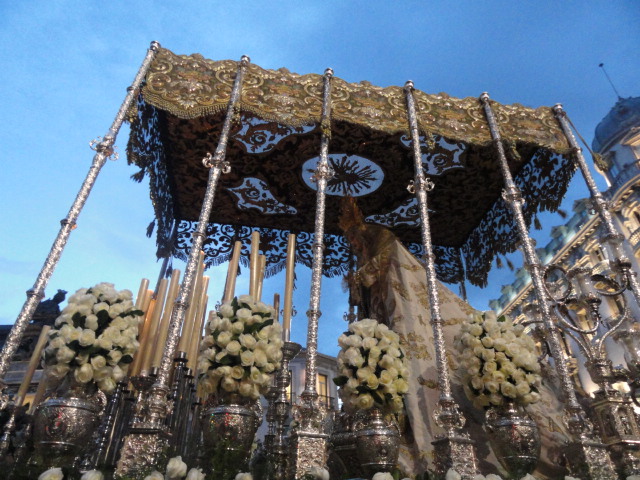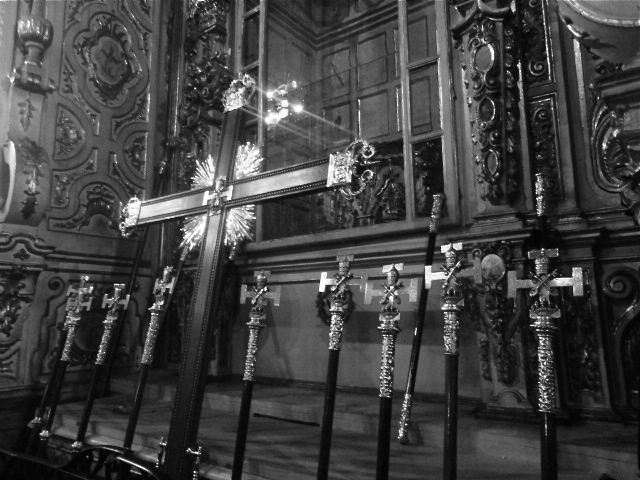Semana Santa, or the Holy Week leading up to Pascua, Easter Sunday in Andalusia, should be on everyone's life bucket list. I've never seen such a joyful and reverential expression of cultural and religious tradition in my life. Each day of the week, a number of pasos, or processions, consisting of costumed members of the church, a uniformed band and a religious image carried on a trono by dozens (as many as 30) costaleros, parade through the city.
With all of my American friends off traveling and no school because Semana Santa is spring break in Spain, I spent an amazing week completely immersed in Spanish culture; viewing processions, speaking tons of Spanish, and spending all of my time with my Spanish friends. I know I've already said this countless times, but I'll say it again - don't spend all of your time traveling while studying abroad. Traveling is amazing, but so is delving into your own host country and its unique culture.
A cloud of incense announces the coming image. Incense and music are an important part of the paso; the distant, haunting sound of the march, the odor of incense and the excitement of people flocking to view the image make it easy to find the processions (luckily, for those of us without itineraries).
I understand the inevitable mental link between the capirotes of the procession participants and the KKK, but the spiritual rituals of Andalusian Semana Santa were around centuries before similar masks became a symbol of intolerance and hate.
A trono making it's dance-like return to its church; these two resourceful kiddos enjoyed the same privileged view as Fray Luis.
2 am, Cristo de los Gitanos (Christ of the Gypsies). This is the most popular procession in Granada, and I've never seen so many people packed into the Sacromonte. Because the road was blocked with people, to watch the procession, we had to hike up and around through the neighborhood. Looking down on this revelry with a view of the Alhambra against the night sky was more than worth it.
The llamador (literally door knocker) on the front of a trono, used to alert the costaleros who carry the - image in absolute darkness, from beneath - to pick up or set down their burden.
Nuns dressed in white praying in a tiny chapel in the Albaicin.
Photographs of the sick placed at this shrine of the Virgin Mary.
When I wasn't watching processions this week, I explored churches of Granada; here more mementos of the sick placed at the feet of Christ.
Jueves Santo, a trono depicting the crucified Christ marching by.
A penitent wearing gold and purple nazareno, or robes, featuring the famous capirote (hood), which I've heard many children here call cucurucho (ice cream cone).
Ok I confess, most of the Virgin Marys look very similar to one another, but each one is nonetheless
very impressive. This one, Nuestra Señora de los Dolores was the only brave soul to make its paso despite the threat of rain on Lunes Santo. Seeing it return to its church (a long, complicated
process of turning around and backing in the doorway) and hearing a saeta (a mournful, flamenco inspired singer) took my breath away.
I was introduced to this image by a friend while it was still being readied for Semana Santa weeks ago. It kicked of the Semana Santa as the first image to leave on Palm Sunday.
The only procession on Sábado Santo, this one is named Hermandad Sacramental de la Santísima Trinidad y Nombre de Jesus y Real e Ilustre Cofardia de Penitencia de Nuestra Señora de las Angustias Coronada de Santa Maria de la Alhambra. It's also called La Virgen de la Alhambra.
After a long afternoon, the image returns to her church in Real de la Alhambra at 1:50 in the morning. Just look at that beautiful silver trono, designed to look like the Moorish architecture of the Alhambra.
Mujer de mantilla, or a woman in the procession wearing a black dress with the traditional peineta (the crown-like comb) and mantilla (lace veil).
This was one of my favorites, a small image carried by children
(I believe it's nicknamed el paso de los niños), when I saw it coming through the crowd
I marveled at how low to the ground and little it is... ah that's why.
A popular Semana Santa pastime amongst younger member of the processional audience - collecting wax. A good example of the Spanish cultural attitude, the processions are loosely organized and surprisingly relaxed, so there is always more than enough time for youngsters to scramble between penitents amassing lovely globs of candle wax.
Don't mind me, just taking a picture of the er, church. Among my friends here in Spain I've developed a reputation as the strange one who takes pictures of other people's children. How can I help it? This little fellow and I had a real connection.
Feet of the costaleros carrying the image on its trono,
walking to the music of the band in sync.
Domingo de Resurrección, the last procession to pass through the city, with the image of the resurrected Christ and pure white nazareno, or penitential robes.
I am so lucky to have such fun, knowledgeable friends to share the Semana Santa with!
(J isn't actually a vampire.)
































No comments:
Post a Comment